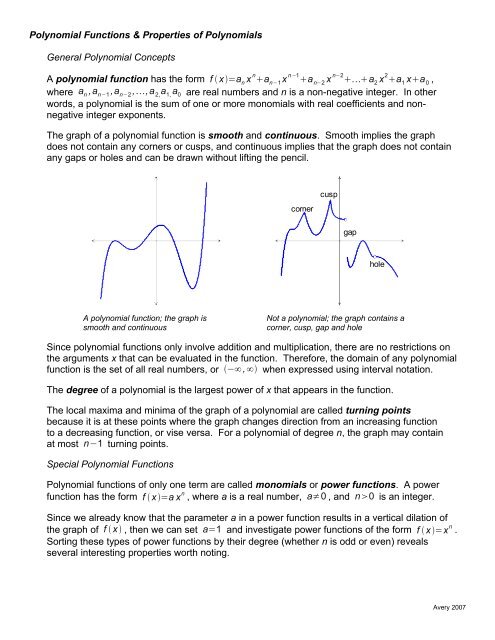Polynomial Functions & Properties of Polynomials General ...
Polynomial Functions & Properties of Polynomials General ...
Polynomial Functions & Properties of Polynomials General ...
You also want an ePaper? Increase the reach of your titles
YUMPU automatically turns print PDFs into web optimized ePapers that Google loves.
<strong>Polynomial</strong> <strong>Functions</strong> & <strong>Properties</strong> <strong>of</strong> <strong>Polynomial</strong>s<br />
<strong>General</strong> <strong>Polynomial</strong> Concepts<br />
A polynomial function has the form f x=a n<br />
x n a n−1<br />
x n−1 a n−2<br />
x n−2 a 2<br />
x 2 a 1<br />
xa 0<br />
,<br />
where a n<br />
,a n−1<br />
,a n−2<br />
,,a 2,<br />
a 1,<br />
a 0 are real numbers and n is a non-negative integer. In other<br />
words, a polynomial is the sum <strong>of</strong> one or more monomials with real coefficients and nonnegative<br />
integer exponents.<br />
The graph <strong>of</strong> a polynomial function is smooth and continuous. Smooth implies the graph<br />
does not contain any corners or cusps, and continuous implies that the graph does not contain<br />
any gaps or holes and can be drawn without lifting the pencil.<br />
corner<br />
cusp<br />
gap<br />
hole<br />
A polynomial function; the graph is<br />
smooth and continuous<br />
Not a polynomial; the graph contains a<br />
corner, cusp, gap and hole<br />
Since polynomial functions only involve addition and multiplication, there are no restrictions on<br />
the arguments x that can be evaluated in the function. Therefore, the domain <strong>of</strong> any polynomial<br />
function is the set <strong>of</strong> all real numbers, or −∞,∞ when expressed using interval notation.<br />
The degree <strong>of</strong> a polynomial is the largest power <strong>of</strong> x that appears in the function.<br />
The local maxima and minima <strong>of</strong> the graph <strong>of</strong> a polynomial are called turning points<br />
because it is at these points where the graph changes direction from an increasing function<br />
to a decreasing function, or vise versa. For a polynomial <strong>of</strong> degree n, the graph may contain<br />
at most n−1 turning points.<br />
Special <strong>Polynomial</strong> <strong>Functions</strong><br />
<strong>Polynomial</strong> functions <strong>of</strong> only one term are called monomials or power functions. A power<br />
function has the form f x=a x n , where a is a real number, a≠0 , and n0 is an integer.<br />
Since we already know that the parameter a in a power function results in a vertical dilation <strong>of</strong><br />
the graph <strong>of</strong> f x , then we can set a=1 and investigate power functions <strong>of</strong> the form f x=x n .<br />
Sorting these types <strong>of</strong> power functions by their degree (whether n is odd or even) reveals<br />
several interesting properties worth noting.<br />
Avery 2007
<strong>Properties</strong> <strong>of</strong> Power <strong>Functions</strong> f x=x n , for n an Odd Integer:<br />
1. The graph is symmetric with respect to the<br />
origin, so f is odd.<br />
2. The domain and the range are the set <strong>of</strong> all<br />
real numbers. Using interval notation, the<br />
domain is −∞,∞ and the range is −∞,∞ .<br />
3. The graph always contains the points 0 ,0 ,<br />
1,1 , and −1,−1 .<br />
4. As n increases in magnitude, the graph<br />
becomes more vertical for ∣x∣1 , but becomes<br />
flatter (and closer to the x-axis) for ∣x∣1 .<br />
<strong>Properties</strong> <strong>of</strong> Power <strong>Functions</strong> f x=x n , for n an Even Integer:<br />
1. The graph is symmetric with respect to the<br />
y-axis, so f is even.<br />
2. The domain is the set <strong>of</strong> all real numbers,<br />
and the range is the set <strong>of</strong> non-negative real<br />
numbers. Using interval notation, the domain<br />
is −∞ ,∞ and the range is [ 0,∞ ) .<br />
3. The graph always contains the points 0 ,0 ,<br />
1,1 , and −1,1 .<br />
4. As n increases in magnitude, the graph<br />
becomes more vertical for ∣x∣1 , but becomes<br />
flatter (and closer to the x-axis) for ∣x∣1 .<br />
End Behavior <strong>of</strong> a <strong>Polynomial</strong> Function<br />
End behavior is the term used to describe how the graph <strong>of</strong> a function behaves for large values<br />
<strong>of</strong> ∣x∣. For the polynomial f x=a n<br />
x n a n−1<br />
x n−1 a n−2<br />
x n−2 a 2<br />
x 2 a 1<br />
xa 0<br />
, the graph will<br />
exhibit end behavior that resembles the graph <strong>of</strong> f x=a n<br />
x n . This is because the leading term<br />
<strong>of</strong> the polynomial “dominates” the polynomial for large values <strong>of</strong> ∣x∣. Using what we know about<br />
power functions, there are only four types <strong>of</strong> end behavior for a polynomial function.<br />
n≥2even;a n<br />
0 n≥2even;a n<br />
0 n≥3odd; a n<br />
0 n≥3odd; a n<br />
0<br />
Avery 2007
Zeros <strong>of</strong> a <strong>Polynomial</strong> Function<br />
From past experience with quadratic functions (which are polynomial functions) we know that<br />
zeros can be real, imaginary, or complex (the zero has a real part and an imaginary part). We<br />
will focus on real zeros at this time and discuss complex zeros in greater detail in the near future.<br />
For a polynomial function f, any number r for which f r =0 is called a zero or root <strong>of</strong> the<br />
function f. Moreover, if r is a zero <strong>of</strong> f, then x −r is a factor <strong>of</strong> f. Finally, if r is a real zero <strong>of</strong> f,<br />
then r is an x-intercept <strong>of</strong> the graph <strong>of</strong> f.<br />
When a polynomial function is completely factored, each <strong>of</strong> the factors help identify zeros <strong>of</strong> the<br />
function. However, since the same factor can occur multiple times, it follows that a zero can<br />
occur multiple times. If x−r is a factor <strong>of</strong> a polynomial m times but not m1 times, then r is<br />
a zero <strong>of</strong> the polynomial m times, and we say that r is a zero <strong>of</strong> multiplicity m.<br />
If r is a zero <strong>of</strong> a polynomial f an even number <strong>of</strong> times, then r is said to be a zero <strong>of</strong> even<br />
multiplicity. Three ways to see that r is a zero <strong>of</strong> even multiplicity are:<br />
When completely factored, x−r is a factor <strong>of</strong> f an even number <strong>of</strong> times, so the power <strong>of</strong><br />
x−r is even.<br />
The sign <strong>of</strong> f x does not change from one side <strong>of</strong> r to the other side <strong>of</strong> r. In other words,<br />
if the value <strong>of</strong> the polynomial f at an argument near r is positive, then the value <strong>of</strong> the<br />
polynomial f at an argument near r, but on the other side <strong>of</strong> r, will also be positive. If the<br />
value <strong>of</strong> the polynomial f at an argument near r is negative, then the value <strong>of</strong> the polynomial<br />
f at an argument near r, but on the other side <strong>of</strong> r, will also be negative.<br />
The graph <strong>of</strong> the polynomial f x touches the x-axis at r.<br />
If r is a zero <strong>of</strong> a polynomial f an odd number <strong>of</strong> times, then r is said to be a zero <strong>of</strong> odd<br />
multiplicity. Three ways to see that r is a zero <strong>of</strong> odd multiplicity are:<br />
When completely factored, x−r is a factor <strong>of</strong> f an odd number <strong>of</strong> times, so the power <strong>of</strong><br />
x−r is odd.<br />
The sign <strong>of</strong> f x changes from one side <strong>of</strong> r to the other side <strong>of</strong> r. In other words, if the<br />
value <strong>of</strong> the polynomial f at an argument near r is positive, then the value <strong>of</strong> the polynomial<br />
f at an argument near r, but on the other side <strong>of</strong> r, will be negative. If the value <strong>of</strong> the<br />
polynomial f at an argument near r is negative, then the value <strong>of</strong> the polynomial f at an<br />
argument near r, but on the other side <strong>of</strong> r, will be positive.<br />
The graph <strong>of</strong> the polynomial f x crosses the x-axis at r.<br />
Avery 2007

















